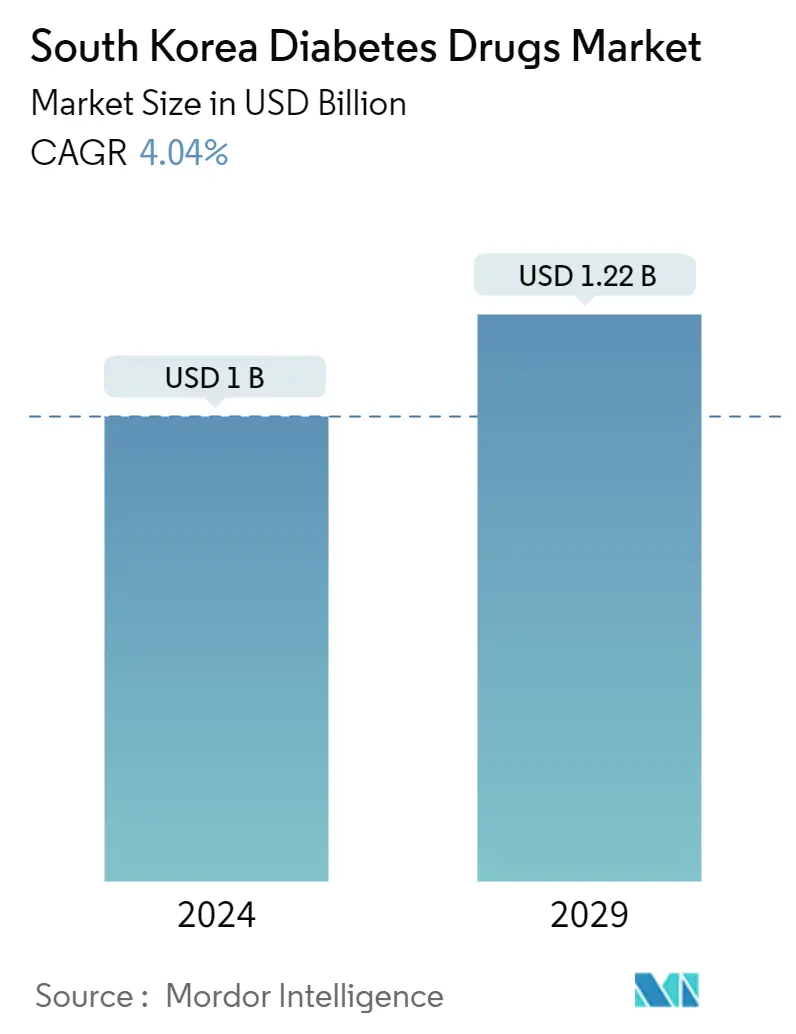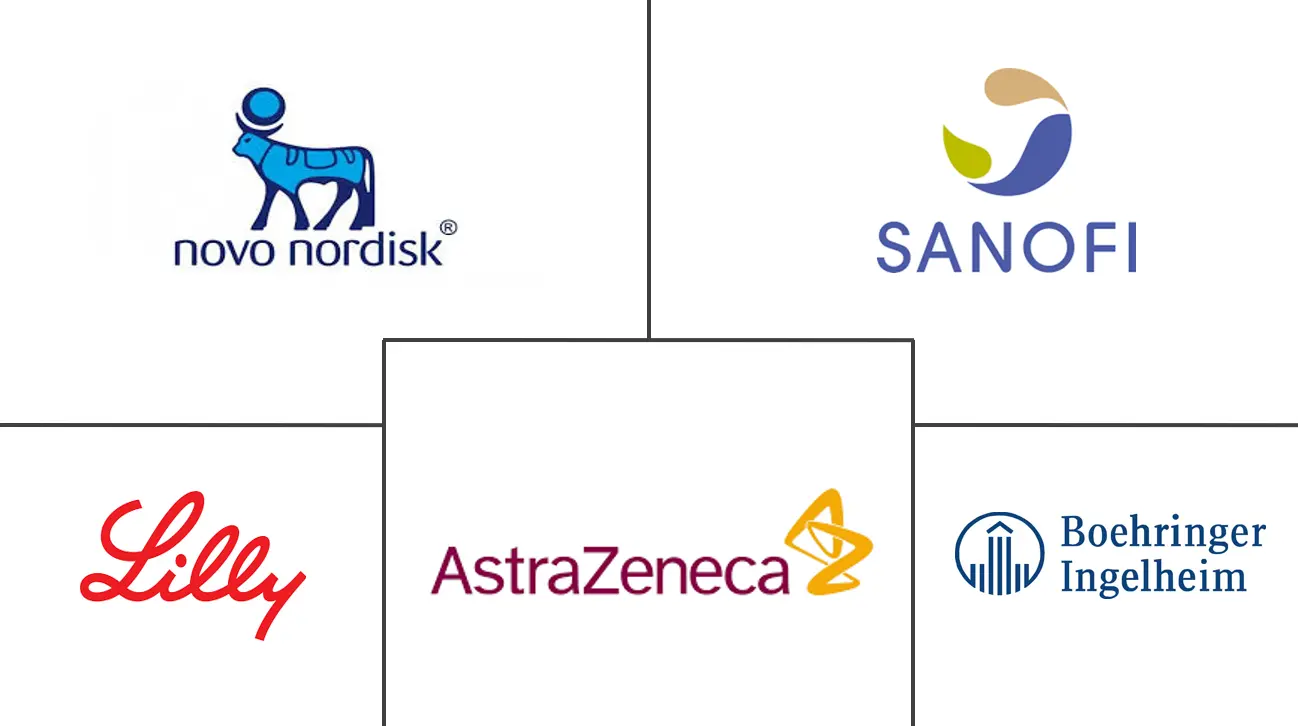Market Size of South Korea Diabetes Drugs Industry

| Study Period | 2021- 2029 |
| Base Year For Estimation | 2023 |
| Market Size (2024) | USD 1 Billion |
| Market Size (2029) | USD 1.22 Billion |
| CAGR (2024 - 2029) | 4.04 % |
| Market Concentration | Medium |
Major Players
*Disclaimer: Major Players sorted in no particular order |
South Korea Diabetes Drugs Market Analysis
The South Korea Diabetes Drugs Market size is estimated at USD 1 billion in 2024, and is expected to reach USD 1.22 billion by 2029, growing at a CAGR of 4.04% during the forecast period (2024-2029).
The COVID-19 pandemic positively impacted the Diabetes Drugs market growth in South Korea. Patients with diabetes, infected with COVID-19 may experience elevated blood glucose, abnormal glucose variability, and diabetic complications. The prevalence of diabetes in people with COVID-19 caused a significant increase in the severity and mortality of COVID-19 in people with either type 1 (T1DM) or type 2 diabetes mellitus (T2DM), especially in association with poor glycemic control. While new-onset hyperglycemia and new-onset diabetes (both T1DM and T2DM) have been increasingly recognized in the context of COVID-19 and have been associated with worse outcomes. To avoid aggravation, a patient's blood glucose should be monitored and managed regularly.
Diabetic drugs are medicines developed to stabilize and control blood glucose levels among people with diabetes. Diabetic drugs are commonly used to manage diabetes. Diabetic drugs have been potential candidates for treating diabetic patients affected by SARS-CoV-2 infection during the COVID-19 pandemic. Diabetes is associated with many health complications. Patients with diabetes require many corrections throughout the day to maintain nominal blood glucose levels, such as administering additional insulin or ingesting additional carbohydrates by monitoring their blood glucose levels. Diabetes poses an emerging healthcare burden across the country and is one of the leading causes of premature death, morbidity, and loss of economic growth.
In South Korea, the prevalence of diabetes in adults is higher and the economic burden of diabetes is higher than that of overall cancer. Diabetic complications or related comorbidities and hospitalization are associated with high costs. Effective strategies are needed to manage patients with diabetic complications and use healthcare resources and reduce the economic burden. It is expected that increased information regarding both the magnitude and the specific components of the economic burden of diabetes in Korea will influence health policymakers to prioritize its prevention and management and to allocate more health care resources to diabetes.
Therefore, owing to the aforementioned factors the studied market is anticipated to witness growth over the analysis period.
South Korea Diabetes Drugs Industry Segmentation
Diabetes Drugs are used to manage Diabetes Mellitus by Lowering the Glucose Level in the Blood. The South Korea Diabetes Drugs Market is Segmented into Drugs (Insulin Drugs, Oral Anti-Diabetic Drugs, Non-Insulin Injectable Drugs, And Combination Drugs). The Report offers the Value (In USD) and Volume (In Units) for the above Segments.
| Insulins | |||||||
| |||||||
| |||||||
| |||||||
|
| Oral Anti-diabetic drugs | ||||||
| ||||||
| ||||||
| ||||||
| ||||||
| ||||||
| ||||||
|
| Non-Insulin Injectable drugs | |||||||
| |||||||
|
| Combination drugs | |||||
| |||||
|
South Korea Diabetes Drugs Market Size Summary
The South Korea Diabetes Drugs Market is poised for growth, driven by the increasing prevalence of diabetes and the economic burden it imposes on the healthcare system. The market is characterized by a significant demand for diabetic drugs, which are essential for managing blood glucose levels and preventing complications associated with diabetes. The COVID-19 pandemic has further underscored the importance of these drugs, as patients with diabetes faced heightened risks during the pandemic. The market is dominated by oral anti-diabetic drugs, which are preferred for their ease of use and cost-effectiveness. These drugs play a crucial role in the long-term management of type 2 diabetes, offering a viable alternative to insulin therapy. The growing awareness and adoption of anti-diabetic medications are expected to contribute to the market's expansion over the forecast period.
The South Korea Diabetes Drugs Market is moderately consolidated, with major players like Eli Lilly, Sanofi, Novo Nordisk, and AstraZeneca holding significant market shares. These companies are actively engaged in strategic mergers and acquisitions to enhance their market presence and explore new revenue streams. The market is also influenced by the National Health Insurance Act, which provides coverage for diabetes treatments, thereby facilitating access to medications. The introduction of innovative drugs, such as glucagon-like peptide-1 receptor agonists, is expected to drive market growth, offering additional benefits beyond glucose control. The collaboration between local and international pharmaceutical companies, as seen in recent partnerships and product launches, further indicates a dynamic market landscape with promising growth prospects.
South Korea Diabetes Drugs Market Size - Table of Contents
-
1. MARKET DYNAMICS
-
1.1 Market Overview
-
1.2 Market Drivers
-
1.3 Market Restraints
-
1.4 Porter's Five Forces Analysis
-
1.4.1 Bargaining Power of Suppliers
-
1.4.2 Bargaining Power of Consumers
-
1.4.3 Threat of New Entrants
-
1.4.4 Threat of Substitute Products and Services
-
1.4.5 Intensity of Competitive Rivalry
-
-
-
2. MARKET SEGMENTATION
-
2.1 Insulins
-
2.1.1 Basal or Long Acting Insulins
-
2.1.1.1 Lantus (Insulin Glargine)
-
2.1.1.2 Levemir (Insulin Detemir)
-
2.1.1.3 Toujeo (Insulin Glargine)
-
2.1.1.4 Tresiba (Insulin Degludec)
-
2.1.1.5 Basaglar (Insulin Glargine)
-
-
2.1.2 Bolus or Fast Acting Insulins
-
2.1.2.1 NovoRapid/Novolog (Insulin Aspart)
-
2.1.2.2 Humalog (Insulin Lispro)
-
2.1.2.3 Apidra (Insulin Glulisine)
-
-
2.1.3 Traditional Human Insulins
-
2.1.3.1 Novolin/Actrapid/Insulatard
-
2.1.3.2 Humulin
-
2.1.3.3 Insuman
-
-
2.1.4 Biosimilar Insulins
-
2.1.4.1 Insulin Glargine Biosimilars
-
2.1.4.2 Human Insulin Biosimilars
-
-
-
2.2 Oral Anti-diabetic drugs
-
2.2.1 Biguanides
-
2.2.1.1 Metformin
-
-
2.2.2 Alpha-Glucosidase Inhibitors
-
2.2.2.1 Alpha-Glucosidase Inhibitors
-
-
2.2.3 Dopamine D2 receptor agonist
-
2.2.3.1 Bromocriptin
-
-
2.2.4 SGLT-2 inhibitors
-
2.2.4.1 Invokana (Canagliflozin)
-
2.2.4.2 Jardiance (Empagliflozin)
-
2.2.4.3 Farxiga/Forxiga (Dapagliflozin)
-
2.2.4.4 Suglat (Ipragliflozin)
-
-
2.2.5 DPP-4 inhibitors
-
2.2.5.1 Onglyza (Saxagliptin)
-
2.2.5.2 Tradjenta (Linagliptin)
-
2.2.5.3 Vipidia/Nesina(Alogliptin)
-
2.2.5.4 Galvus (Vildagliptin)
-
-
2.2.6 Sulfonylureas
-
2.2.6.1 Sulfonylureas
-
-
2.2.7 Meglitinides
-
2.2.7.1 Meglitinides
-
-
-
2.3 Non-Insulin Injectable drugs
-
2.3.1 GLP-1 receptor agonists
-
2.3.1.1 Victoza (Liraglutide)
-
2.3.1.2 Byetta (Exenatide)
-
2.3.1.3 Bydureon (Exenatide)
-
2.3.1.4 Trulicity (Dulaglutide)
-
2.3.1.5 Lyxumia (Lixisenatide)
-
-
2.3.2 Amylin Analogue
-
2.3.2.1 Symlin (Pramlintide)
-
-
-
2.4 Combination drugs
-
2.4.1 Insulin combinations
-
2.4.1.1 NovoMix (Biphasic Insulin Aspart)
-
2.4.1.2 Ryzodeg (Insulin Degludec and Insulin Aspart)
-
2.4.1.3 Xultophy (Insulin Degludec and Liraglutide)
-
-
2.4.2 Oral Combinations
-
2.4.2.1 Janumet (Sitagliptin and Metformin)
-
-
-
South Korea Diabetes Drugs Market Size FAQs
How big is the South Korea Diabetes Drugs Market?
The South Korea Diabetes Drugs Market size is expected to reach USD 1 billion in 2024 and grow at a CAGR of 4.04% to reach USD 1.22 billion by 2029.
What is the current South Korea Diabetes Drugs Market size?
In 2024, the South Korea Diabetes Drugs Market size is expected to reach USD 1 billion.

